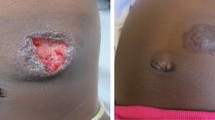Abstract
Purpose
Infantile haemangiomas comprise the majority of vascular anomalies and are considered the predominant vascular tumour type 1. We performed this prospective study to evaluate the therapeutic response and propranolol tolerance in infants with ulcerated infantile haemangioma of head and neck region.
Methods
Sixty-four patients with ulcerated infantile haemangiomas (IHs) of head and neck region, without any prior treatment and with age older than 1 month, were included in the study, after informed consent was obtained, and were randomly divided into groups A and B. Group A patients were given oral propranolol at a dose of 2 mg/kg per day in three divided doses as outpatients. Group B patients were given oral ibuprofen at a dose of 10 mg/kg 8-hourly and paracetamol at dose of 16.2 mg/kg 8-hourly. Documentation of gender, age, haemangioma location, duration of ulceration and pain was measured on the second and fifth day after commencement of treatment in both groups using the Children’s Hospital of Eastern Ontario Pain Scale.
Results
There was no difference in pain score between the two groups (P value 0.074). Mean duration of healing of ulceration in group A was 17.93 ± 2.22 days and in group B was 27.71 ± 2.33 days (P value <0.001). In group A, out of 28 patients, 8 (28.5 %) were complete responders, 16 (57.1 %) were partial responders and 4 (14.2 %) were non-responders.
Conclusion
Propranolol is a valuable therapeutic alternative for treatment of ulcerated haemangiomas and effectively reduces pain.


Similar content being viewed by others
References
Buckmiller LM, Munson PD, Dyamenahalli U, Dai Y, Richter GT (2010) Propranolol for infantile hemangiomas: early experience at a tertiary vascular anomalies center. Laryngoscope 120:676–681
Leaute-Labreze C, Dumas de la Roque E, Hubiche T, Boralevi F, Thambo JB, Taıeb A (2008) Propranolol for severe hemangiomas of infancy. N Engl J Med 358:2649–2651
Buckmiller LM (2009) Propranolol treatment for infantile hemangiomas. Curr Opin Otolaryngol Head Neck Surg 17:458–459
Siegfried EC, Keenan WJ, Al Jureidini S (2008) More on propranolol for hemangiomas of infancy. N Engl J Med 359:2846–2847
Naouri M, Schill T, Maruani A et al (2010) Successful treatment of ulcerated haemangioma with propranolol. J Eur Acad Dermatol Venereol 24(9):1109–1112
Kim HJ, Colombo M, Frieden IJ et al (2001) Ulcerated hemangiomas: clinical characteristics and response to therapy. J Am Acad Dermatol 44:962–972
Kima HCL, Hogeling M, Wargon O, Ashish Jiwane A, Adamsa S (2011) Propranolol: useful therapeutic agent for the treatment of ulcerated infantile hemangiomas. J Pediatr Surg 46:759–763
Jean MS, Labreze CL, Hautier JM (2011) Propranolol appears to be an effective and well-tolerated treatment for ulcerated IH. J Am Acad Dermatol 64:827–832
C McGrath PJ, Johnson G et al (1985) CHEOPS: A behavioral scale for rating postoperative pain in children. Adv Pain Research Therapy; 9: 395-402. (http://www.modernmedicine.com/sites/default/files/images/Resource-Centers/Children’s%20Hospital%20of%20Eastern%20Ontario%20Pain%20Scale%20(CHEOPS).pdf )
Mitchell P (1999) Understanding a young child’s pain. Lancet 354:1708
Drolet BA, Esterly NB, Frieden IJ (1999) Hemangiomas in children. N Engl J Med 341(3):173–181
Bruckner AL, Frieden IJ (2003) Hemangiomas of infancy. J Am Acad Dermatol 48(4):477–493
Metz BJ, Rubenstein MC, Levy ML et al (2004) Response of ulcerated perineal hemangiomas of infancy to becaplermin gel, a recombinant human platelet-derived growth factor. Arch Dermatol 140:867–870
Chamlin SL, Haggstrom AN, Drolet BA et al (2007) Multicenter prospective study of ulcerated hemangiomas. J Pediatr 151:684–689
Thomas RF, Hornung RL, Manning SC et al (2006) Hemangiomas of infancy: treatment of ulceration in the head and neck. Pediatrics 118(3):882–887
Morelli JG, Tian Tan O, Yohn JJ (1994) Treatment of ulcerated hemangiomas in infancy. Arch Pediatr Adolesc 148:1104–1106
Poetke M, Philipp C, Berlien HP (2000) Flashlamp-pumped pulsed dye laser for hemangiomas in infancy. Arch Dermatol 136:628–632
Witman PM, Wagner AM, Scherer K et al (2006) Complications following pulsed dye laser treatment of superficial hemangiomas. Lasers Surg Med 38:116–123
Wasong SJ, Klepeiss SA, Zaenglein AL (2008) Picture of the month. Ulcerated infantile hemangioma. Arch Pediatr Adolesc Med 162(9):893–894
Sans V, Dumas DLR, Berge J et al (2009) Propranolol for severe infantile hemangiomas: follow-up report. Pediatrics 124:423–431
Mousa W, Kues K, Haas E et al (2010) Successful treatment of a large hemangioma with propranolol. J Dtsch Dermatol Ges 8(3):184–186
D’Angelo G, Lee H, Weiner RI (1997) cAMP-dependent protein kinase inhibits the mitogenic action of vascular endothelial growth factor and fibroblast growth factor in capillary endothelial cells by blocking Raf activation. J Cell Biochem 67:353–366
Sommers Smith SK, Smith DM (2002) Beta blockade induces apoptosis in cultured capillary endothelial cells. In Vitro Cell Dev Biol Anim 38:298–304
Hermans DJ, Boezeman JB, Van de Kerkhof PC, Rieu PN, Van der Vleuten CJ (2009) Differences between ulcerated and nonulcerated hemangiomas, a retrospective study of 465 cases. Eur J Dermatol 19:152–156
Storch CH, Hoeger PH (2010) Propranolol for infantile hemangiomas: insights into the molecular mechanisms of action. Br J Dermatol 163:269–274
Mohammadi AA, Bakhshaeekia A, Alibeigi P, Hasheminasab MJ, Tolide-ei HR, Tavakkolian AR et al (2009) Efficacy of propranololin wound healing for hospitalized burn patients. J Burn Care Res 30:1013–1017
Qin ZP, Liu XJ, Li KL, Zhou Q, Yang XJ, Zheng JW (2009) Treatment of infantile hemangiomas with low-dose propranolol: evaluation of short-term efficacy and safety. Zhonghua Yi Xue Za Zhi 89:3130–3134
Pandey V, Tiwari P, Gangopadhyay AN, Gupta DK, Sharma SP, Kumar V (2014) Propranolol for infantile haemangiomas: experience from a tertiary center. J Cutan Aesthet Surg 7:37–41
Bruckner AL, Frieden IJ (2003) Hemangiomas of infancy. J Am Acad Dermatol 48:477–493
Author information
Authors and Affiliations
Corresponding author
Rights and permissions
About this article
Cite this article
Tiwari, P., Pandey, V., Gangopadhyay, A.N. et al. Role of propranolol in ulcerated haemangioma of head and neck: a prospective comparative study. Oral Maxillofac Surg 20, 73–77 (2016). https://doi.org/10.1007/s10006-015-0528-z
Received:
Accepted:
Published:
Issue Date:
DOI: https://doi.org/10.1007/s10006-015-0528-z




